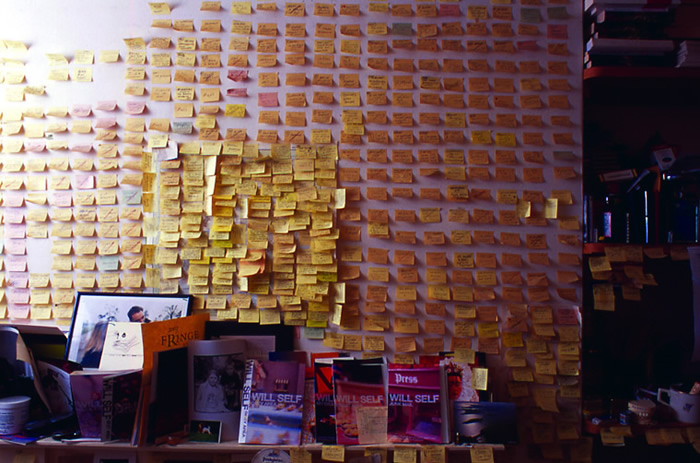I take my commitment to public education and to presenting my work in new digital formats extremely seriously, which is why, from now on, each instalment of On Location will be accompanied by a riveting and informative film. The first of these, Will Self’s Alley, can now be viewed on YouTube.
It’s a five-minute film, shot in real time and unedited, which shows my point of view as I take a 35-yard walk along an alley near my house, the camera bobbing, weaving and corkscrewing down into the tangles of ivy and other shrubbery wreathing the chain-link fence to discover exciting pieces of detritus. After about three minutes, a woman and her child pass by – you don’t see them but you can hear them commenting on my dog (the child refers to Maglorian as a puppy; in reality, he’s seven years old but on the small side, even for a Jack Russell); at around four minutes in, I call the dog, and about 30 seconds later I remark on how absorbing it is to film rubbish strewn along an alley. Apart from these interjections, the film is without commentary and silent, other than my slightly laboured breathing and the scrape of my sensible Clarks shoes on damp tarmacadam.
What’s not to admire about this film? In succession we are introduced to the following: the corpse of an Argos catalogue bloated with rainwater; an upended plastic flowerpot; waxed-paper coffee cups; Guinness and other beer cans; apple juice cartons and a paradoxically static McFlurry container; a turkey baster perhaps abandoned after some strange act of artificial insemination (particularly strange because the alley runs alongside a small Catholic church); a Ribena carton and the serendipitous sequence of two empty Polish beer cans – Lech followed by Tyskie – which suggests sexual incontinence followed by an admonition. This is by no means an exhaustive list; nor does it convey the subtlety of the film’s camerawork, as we nose in and out of the shrubbery, teasing apart leaves to expose shyly sheltering Jack Daniel’s miniatures.
I’d like to tell you that Will Self’s Alley was inspired by a recent hit BBC4 film, All Aboard! The Canal Trip, but I heard about this only after it was broadcast – its executive producer, Clare Paterson, was interviewed on the Today programme and she said she was indeed surprised that the two-hour film, shot entirely on a camera attached to the prow of a narrowboat travelling along the Kennet and Avon Canal, had drawn an audience of 600,000 viewers. I’m not surprised at all. We’re a nation of fat and lazy bastards – so fat and lazy that we’d rather slump at home watching the canal banks pass by at a soporific four miles per hour than go to the bother of actually slumping on a narrowboat and watching them pass by . . . live.
Ms Paterson said that her film had no soundtrack – only ambient splishes and sploshes – while information was confined to little gobbets of text that were digitally imprinted on passing lock gates or waterfowl. Will Self’s Alley is similarly bare-bones but it has the added virtue of any text portrayed being entirely aleatoric – so stick that in your pipe, Paterson. (Although don’t try smoking it, or the corporation will send you to rehab.)
What Paterson seemed wholly unaware of was the lineage of this sort of film. Patrick Keiller, the doyen of psychogeographic film-makers, has written about it at length in his collection of essays The View from the Train. So-called phantom rides, in which a camera was attached to the front of a train or a tram, were a staple of early cinema: the topographic selfies of the 1890s and 1900s which, as Keiller sagely remarks, paradoxically revealed to viewers the nature of their environment through a new technology that was itself transformative of that very milieu.
If you don’t think that film hugely alters our relationship to place, just consider the phantom ride of our own era. Instead of a single reel depicting the astonishing perspective afforded by wheeled vehicles in an urban context, our licence fees pay – in part – for two hours of lackadaisical nostalgia and lazy nature-gawping. The compelling feature of virtuality (as I’ve had cause to remark in these pages in the past) is that it renders subjective movement unnecessary. The world truly begins to revolve around us, confirming our utterly specious view that we are in control.
I used to think that the most depressing words in the English language were “rail replacement service” but I have come to believe “We are now approaching Staines” are even more dolorous. Yet it’s a misery that we should embrace, because the modern Britain we experience from day to day consists not of beautifully restored 18th-century canals (I’ve walked the Kennet and Avon and know just how bosky it can be) but of Staines and of alleys strewn with detritus. Paterson’s film is a ghostly cruise into a time and a place that never really existed (those lovely canals were dug by sweated and immiserated labourers), whereas mine is a walk on the wildly ordinary side. All Aboard! – no matter how utilitarian – will have entailed the expenditure of considerable time and money, whereas Will Self’s Alley cost nothing to make and costs nothing to view. So why not just do that and knock Paterson’s vaunted ratings into a hatted cock?
